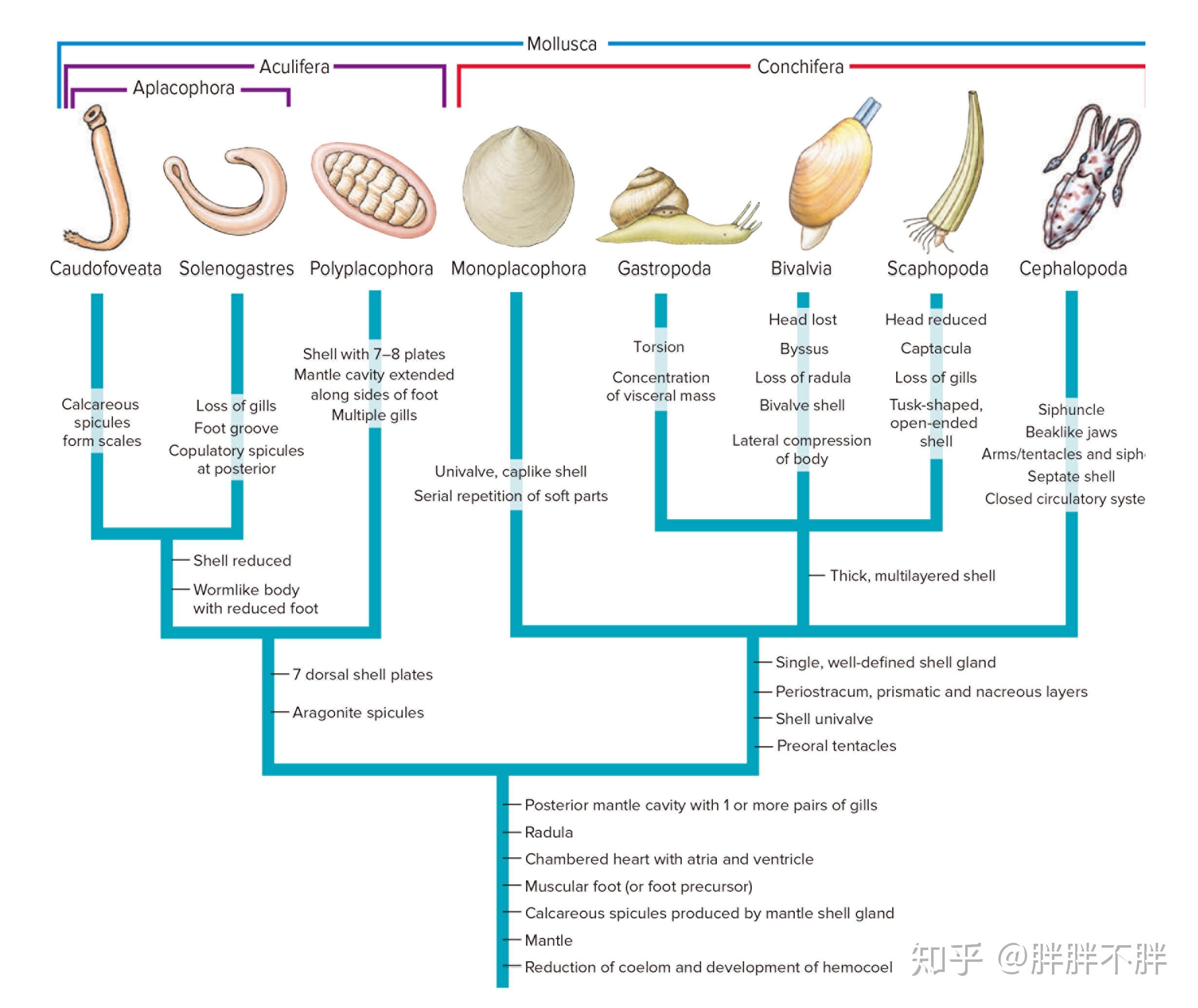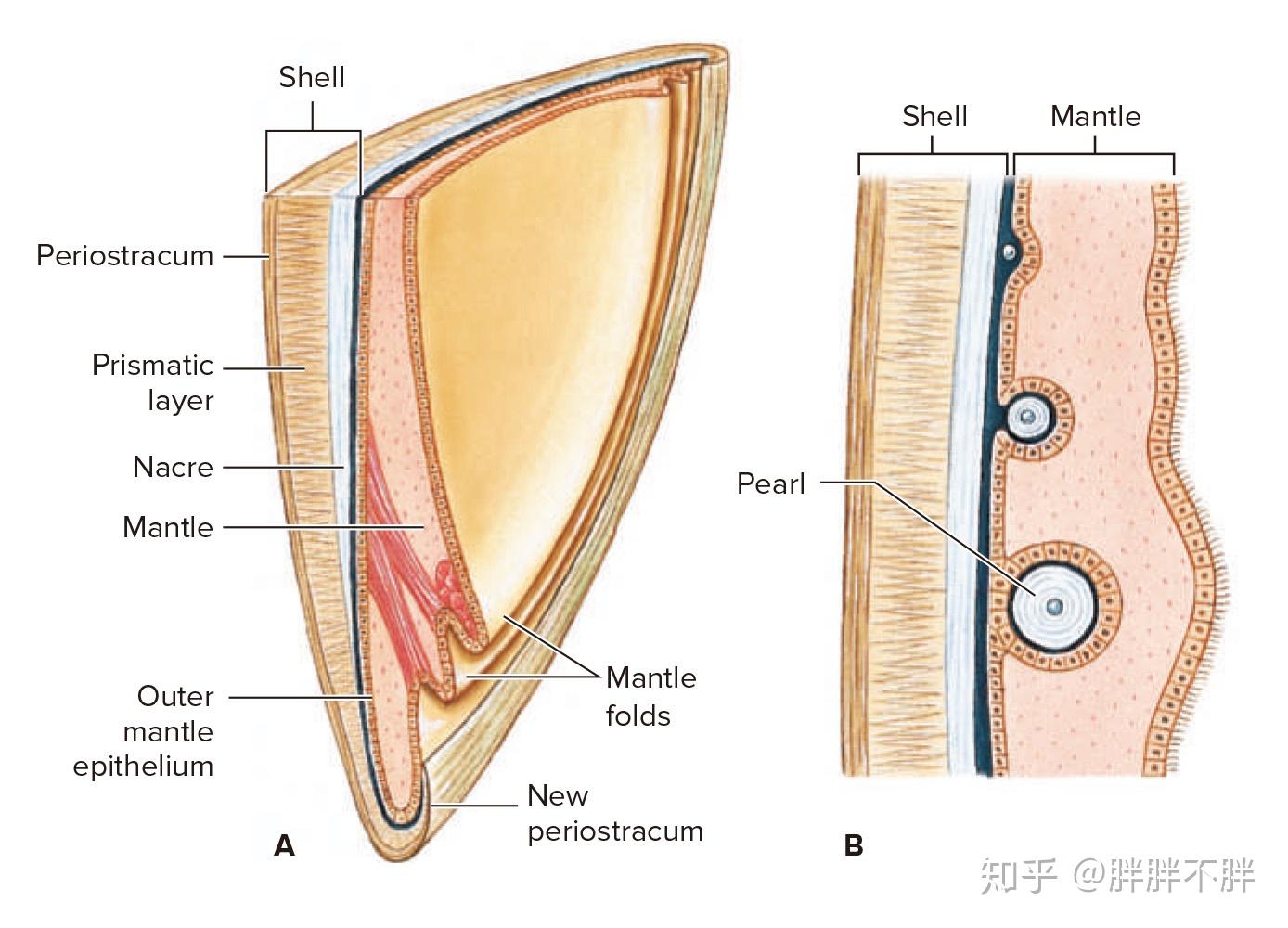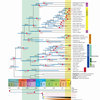生物学笔记 · 软体动物门
Characteristics of Phylum Mollusca
软体动物门的特征

- Dorsal body wall forms pair of folds called the mantle, which encloses the mantle cavity, is modified into gills or lungs, and secretes the shell (shell absent in some); ventral body wall specialized as a muscular foot, variously modified but used chiefly for locomotion; radula in mouth.
外套膜是背侧体壁形成的一对褶皱,内裹外套腔,可形成鳃或肺,并分泌贝壳(部分无贝壳);腹侧体壁特化为肌肉足,形态各异但主要用于运动;口腔有齿舌。

2. Live in marine, freshwater, and terrestrial habitats.
生活在海洋、淡水和陆地。
3. Free-living or occasionally parasitic.
多数营自由生活,少数寄生。
4. Body bilaterally symmetrical (bilateral asymmetry in some); unsegmented; often with definite head.
身体两侧对称(部分两侧不对称);不分段;通常有明确的头部。
5. Triploblastic body.
身体三胚层。
6. Coelom limited mainly to area around heart, and perhaps lumen of gonads, part of kidneys, and occasionally part of the intestine.
体腔主要局限于心脏周围区域,可能还包括生殖腺和部分排泄器官内腔,偶尔还有部分肠腔。
7. Surface epithelium usually ciliated and bearing mucous glands and sensory nerve endings.
表皮通常有纤毛、粘液腺和感觉神经末梢。
8. Complex digestive system; rasping organ (radula) usually present; anus usually emptying into mantle cavity; internal and external ciliary tracts often of great functional importance.
复杂的消化系统;通常具有齿舌,似锉刀;肛门通常开口于外套腔;内部和外部的纤毛束通常具有非常重要的功能。
9. Circular, diagonal, and longitudinal muscles in the body wall; mantle and foot highly muscular in some classes (for example, cephalopods and gastropods).
体壁具有环肌、斜肌和纵肌;部分纲具有外套膜和高度发达的足部肌肉(例如,头足纲和腹足纲类)。
10. Nervous system of paired cerebral, pleural, pedal, and visceral ganglia, with nerve cords and subepidermal plexus; ganglia centralized in nerve ring in gastropods and cephalopods.
神经系统由脑神经节、侧神经节、足神经节、脏神经节四对神经节以及神经索和表皮下神经丛组成;腹足纲和头足纲类群的神经节集中在神经环。
11. Sensory organs of touch, smell, taste, equilibrium, and vision (in some); the highly developed direct eye (photosensitive cells in retina face light source) of cephalopods is similar to the indirect eye (photosensitive cells face away from light source) of vertebrates but arises as a skin derivative in contrast to the brain eye of vertebrates.
具有触觉、嗅觉、味觉、平衡和视觉(部分)感觉器官;头足纲类群高度发达的direct eye(光敏细胞在视网膜的前方,正对光源)与脊椎动物的indirect eye(光敏细胞在视网膜的后方,远离光源)相似,但与脊椎动物的brain eye不同,它是作为皮肤的衍生物出现的。

12. No asexual reproduction.
没有无性繁殖。

13. Both monoecious and dioecious forms; spiral cleavage; ancestral larva a trochophore, many with a veliger larva, some with direct development.
存在雌雄同体和雌雄异体;螺旋卵裂;原始的发育过程经历担轮幼虫阶段,多数还存在面盘幼虫阶段,少数直接发育。

14. One or two kidneys (metanephridia) opening into the pericardial cavity and usually emptying into the mantle cavity.
一个或两个肾(后肾管)与围心腔相通,通常开口于外套腔。
15. Gaseous exchange by gills, lungs, mantle, or body surface.
通过鳃、肺、外套膜或体表进行气体交换。
16. Open circulatory system (secondarily closed in cephalopods) of heart (usually three chambered), blood vessels, and sinuses; respiratory pigments in blood.
开管式循环系统(头足纲类群基本为闭管式循环系统),由心脏(通常为三腔)、血管和血窦组成;血液中有呼吸色素。
翻译:duo
审稿:xtone

